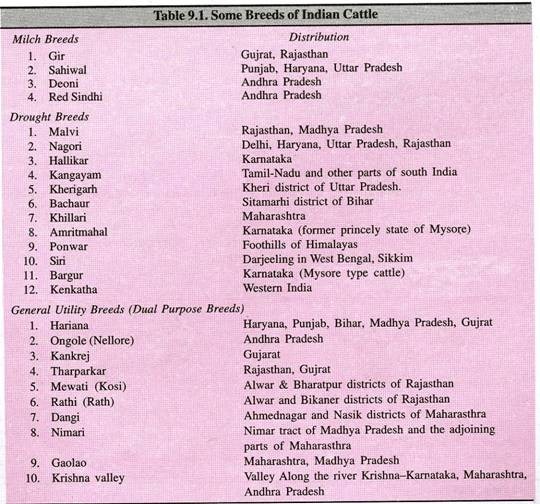ADVERTISEMENTS:
Proteins are classified in various ways: 1. Simple Proteins 2. Conjugated Proteins 3. Derived Proteins.
1. Simple Proteins:
These are pure proteins, uncombined with anything else.
The important members of this group are as follows:
ADVERTISEMENTS:
(a) Protamines:
Found in the sperm of certain fishes; molecular wt. low, about 2000; strongly basic in character, not coagulated by heat and soluble in ammonium hydroxide.
Histones:
Occur in thymus gland and also in haemoglobin (the globin part). Coagulates on boiling in presence of salts. Soluble in water and dilute mineral acids. Precipitated from watery solution by adding ammonia but soluble in excess of the reagent. They are basic in reaction and the most characteristic feature is the high proportion of diamino acids in the molecule.
ADVERTISEMENTS:
(b) Albumins:
They have amphoteric reaction, soluble in distilled water as well as in salt solutions; coagulated by heat, acids and alkalies. They are precipitated by complete saturation by ammonium sulphate or zinc sulphate.
They include the following:
i. Egg Albumin:
Forms 10-12% of egg-white. It is heat coagulable and precipitated by adding a drop of dilute acetic acid, in excess of ether. It is laevorotatory, rotation being -35.5.
ii. Serum Albumin:
Occurs in serum (4-5%), lymph, tissue fluid, etc. Coagulates at 75°C, differs from egg albumin by its greater rotation (-56) and also by the fact that it is not precipitated by ether and acetic acid.
iii. Lactalbumin:
Found in milk.
ADVERTISEMENTS:
iv. Myoalbumin:
Found in muscle.
v. Leucosin:
It is a vegetable protein found in wheat.
ADVERTISEMENTS:
Some of the albumins are now known to contain carbohydrate radicals and so truly belong to the conjugated protein group.
(c) Globulins:
Insoluble in distilled water but soluble in dilute salt solutions. Coagulated by heat and acids, precipitated by full saturation with magnesium sulphate, NaCl and by half saturation with ammonium sulphate.
The important members of this class are the following:
ADVERTISEMENTS:
i. Serum Globuin:
Occurs in plasma, serum, etc.
ii. Ovoglobulin:
Found in egg-yolk.
ADVERTISEMENTS:
iii. Crystallin:
Found in the crystalline lens of the eye.
iv. Fibrinogen:
Present in plasma and is converted into fibrin during coagulation.
v. Vegetable Proteins:
Found in vegetables for instance, edestin from hemp, cotton, etc., legumin from peas.
ADVERTISEMENTS:
vi. Myosin:
Found in muscle.
(d) Prolamines:
Found in maize, barley, wheat, etc., soluble in 70 to 80% dilute alcohol and insoluble in absolute alcohol and water. Example-zein (maize) and gliadin (wheat).
(e) Glutelins:
Obtained from cereals, soluble in weak acids and alkalies, but insoluble in neutral solution. They are coagulated by heat.
ADVERTISEMENTS:
(f) Scleroproteins (Albuminoids):
They are least soluble of all the proteins.
i. Keratin:
Found in hoofs, horns, nails, and hairs etc., Rich in sulphur.
ii. Elastin:
Found in elastic tissue, cartilage and ligament.
iii. Collagen:
Found in white fibrous tissue, bone and cartilage.
iv. Ossein:
Found in bone and teeth.
2. Conjugated Proteins:
In these compounds the protein molecule remains conjugated with another non-protein prosthetic group.
This class includes the following:
(a) Chromoproteins:
Here the non-protein substance (prosthetic group) is a colouring matter.
The following are the important chromoproteins:
i. Haemoglobin:
Here the simple protein-globin remains united with an iron-containing pigment haem.
ii. Visual Purple (Rhodopsin):
In the retina, prosthetic group is a carotenoid pigment.
iii. Cytochrome:
Conjugated protein containing haem.
iv. Flavoprotein:
Riboflavin as the prosthetic group.
v. Haemocyanin:
The blood pigment of Crustacea. The pigment part contains copper.
vi. Catalase and Peroxidase:
Two separate enzymes, the prosthetic group in both are haem.
(b) Phosphoproteins:
Caseinogen of milk, vitellin of egg- yolk, etc. Here the protein molecule remains combined with phosphoric acid. They are markedly acidic in character, insoluble in water but soluble in alkalies. Their solution in alkali is not coagulated by heat.
(c) Nucleoproteins:
This protein contains phosphoric acid and also other prosthetic group. Hence, it should be placed in a special class. Nucleoproteins are formed by the union of nucleic acid with two molecules of proteins. The nucleic acid is made up of four mononucleotides.
Each mononucleotide is again composed of three different compounds e.g.:
1. Phosphoric Acid.
2. Carbohydrate:
The carbohydrate present in nucleic acid is a pentose. In deoxyribonucleic acid (DNA) present in cell nucleus, the pentose is deoxyribose, whereas ribose is present in ribonucleic acid (RNA) occurring in cytoplasm of cell and also in nucleolus.
3. Nitrogenous Bases:
The bases are of two types:
i. Purine Bases:
Adenine (6-aminopurine) and guanine (2-amino-6-oxypurine), both are present in DNA and RNA.
ii. Pyrimidine Bases:
The pyrimidine bases are cytosine (2-oxy-4-aminopyrimidine), uracil (2, 4-dioxypyrimidine) and thymine (5-methyl-2-4-dioxypyrimidine). Cytosine is present in both DNA and RNA. Thus RNA contains adenine, guanine, cytosine and uracil, whereas DNA contains adenine, guanine, cytosine and thymine.
Nucleic Acids:
The nucleic acids are necessary for synthesis of protein in the body.
There are four types of nucleic acids:
1. DNA or deoxyribonucleic acid containing D-2-deoxyribose is mainly present in cell nucleus especially in the chromosomes, but other portions of the cell, like mitochondria also contain DNA. Being present in the chromosomes it is associated with storage and expression of genetic information of heredity. Structure of a DNA molecule shows the two nucleic acid chains to twist in a double helix (Fig. 1.13).
2. Messenger RNA (mRNA) is formed on the strands of DNA and is responsible for carrying information from the nucleus to the area where protein is synthesised. mRNA leaves the nucleus and is stretched itself over the ribosomal surface so as to direct the synthesis of protein (Fig. 1.14). RNA is ribonucleic acid containing D-ribose and like mRNA there is also tRNA and rRNA.
3. Transfer RNA (tRNA) is responsible for transferring specific amino acids to the site of protein synthesis where the mRNA has already stretched over the ribosomal surface and thus expresses the genetic information. The amino acid sequences are determined by the tRNA because it recognises the code for the amino acids that are carrying at the site of protein synthesis where the mRNA has already been attached. The molecular weight of tRNA is 20,000-30,000 and is present in the cytoplasm.
4. Ribosomal RNA (rRNA) is found as minute granules in the ribosome,—the protein-synthesising centres of the cells and has got molecular weight of about 2,000,000.
(d) Glycoproteins and Mucoproteins:
In these compounds the protein molecule remains combined with a carbohydrate radicle, containing nitrogen, viz., hexosamines glucosamine or galactosamine. Glucosamine and galactosamine are also known as amino sugars. Distinction between glycoprotein and mucoprotien is due to percentage of carbohydrate present. Compound containing less than 4 per cent carbohydrate is glycoprotein and containing more than 4 per cent carbohydrate is mucoprotien.
The carbohydrate part is a tetrasaccharide, being made up of two molecules of acetyl hexosamine, which are united through two molecules of glucuronic acid. Glycoprotiens may be divided into two groups-the mucins and the mucoids. Mucins are present in the mucous secretions of glands and of mucous membranes.
They are not coagulable by heat, precipitated by acids and the precipitate redissolves in alkali. The hexosamine derived from mucin is a glucosamine, called mucoitin. On being boiled with acids the molecule gives acid metaprotein and another compound, mucoitin sulphuric acid.
The mucoids include a number of compounds which may be extracted from tendons, bones, cartilages, eggs, etc., by dilute alkali. The ovomucoid is derived from egg-white, the chondromucoid is found in the cartilages and bones. The hexosamine present in such compounds is galactosamine and is called chondroitin.
On hydrolysis the chondromucoid yields protein and both mucoitin sulphuric acid and chondroitin sulphuric acid. It has been shown that both serum albumin and serum globulin contain a carbohydrate radicle, consisting of glucosamine and mannose. Heparin is probably a derivative of some compound resembling chondroitin sulphuric acid.
(e) Lipoproteins:
In these compounds the proteins remain united with lipid. The latter generally belongs to the class of phospholipids. It has been derived from plasma, blood corpuscles, eggs, milk etc.
(f) Metalloproteins:
Protein-containing metallic elements, like Fe, Cu, Mn, Mg, Co, etc., found in a large variety of enzymes.
3. Derived Proteins:
These proteins are not present in nature as such. They are found as products of hydrolysis of the native protein molecule.
The gradual stages are as follows:
Protein → Protean → Metaprotein → Proteose → Peptone → Peptides → Amino Acids.
(a) Proteans:
They are formed especially from certain globulins but differ from them in being insoluble in dilute salt solutions. Edestan from edestin and myosan from myosin are typical examples of this class.
(b) Metaproteins:
Metaproteins are coagulated by heat, soluble in excess of acid and alkali and are precipitated at isoelectric point or pH.
Metaproteins are of two varieties-acid and alkali:
ADVERTISEMENTS:
i. Acid Metaprotein:
The acid metaprotein is formed by the action of dilute acids on proteins. When the solution is neutralised with dilute alkali the acid metaprotein is precipitated.
ii. Alkali Metaprotein:
The alkali metaprotein is formed by the action of alkali and is precipitated on being neutralised by acids.
Proteoses (such as albumose from albumin, gelatose from gelatin, caseose from casein, etc.):
Proteoses are soluble in water, not coagulated by heat, give violet biuret reaction. They are also soluble in weak salt solutions, acids and akalies.
Proteoses are of two classes:
i. Primary Proteoses:
Precipitated by half saturation with ammonium sulphate and full saturation with magnesium or sodium sulphate.
ii. Secondary Proteoses:
Precipitated by full saturation with ammonium sulphate. The proteoses are precipitated by Esbach’s solution. The precipitate dissolves on heating and reappears on cooling.
(c) Peptones:
Peptones give a red biuret reaction. They are not coagulated by heat, not precipitated by usual precipitating reagents, soluble in water and generally soluble in alcohol. They may be precipitated by tannic acid, phosphotungstic acid, phosphomolybdic acid, etc. Their molecules are of small size and hence do not behave like colloids. Like crystalloids they are easily diffusible through animal membranes.
(d) Polypeptides:
Polypeptides do neither give biuret reaction, nor coagulation reaction nor precipitation reaction. On further hydrolysis the polypeptides yield lower peptides which are finally broken down into amino acids.




